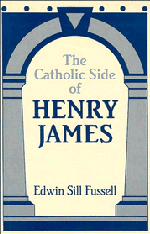Book contents
- Frontmatter
- Contents
- Preface
- Calendar: Chief Items of Catholic Interest in Henry James
- Documentation
- Dedication
- Part One Bibliographical Leads, Historical Considerations
- Part Two Representing Catholicity
- Part Three The Narratives of Catholic Conversion
- Part Four Pas de quatre
- Part Five The Catholic Ménage as Literary Space
- Part Six “Prove That I'm Not!” – Toward the Impossibility of Interpretation
- Notes
- Index
- Cambridge Studies in American Literature and Culture
Part Five - The Catholic Ménage as Literary Space
Published online by Cambridge University Press: 19 March 2010
- Frontmatter
- Contents
- Preface
- Calendar: Chief Items of Catholic Interest in Henry James
- Documentation
- Dedication
- Part One Bibliographical Leads, Historical Considerations
- Part Two Representing Catholicity
- Part Three The Narratives of Catholic Conversion
- Part Four Pas de quatre
- Part Five The Catholic Ménage as Literary Space
- Part Six “Prove That I'm Not!” – Toward the Impossibility of Interpretation
- Notes
- Index
- Cambridge Studies in American Literature and Culture
Summary
“De Grey: A Romance” (1868)
“God be with you!;” and the old man crossed himself. Involuntarily, Margaret did the same.
The term ménage may include a family, a household, a tightly knit neighborhood or comparable community such as a parish, or even certain combinations of these, for example, the extended family situations of Guy Domville or the unusually interchanging households of Portland Place and Eaton Square in The Golden Bowl. In both those works, and in “De Grey: A Romance” as well, Roman Catholic ménage serves the aesthetic purpose of defining and delimiting a literary space, within which the unities of action and setting may swell to their limits and not beyond. In all three works there is also stated or implied a religious, cultural, and sociological comment along somewhat the same lines: Roman Catholics in the United States and in England, in basically Protestant countries, are either through their own fault or the fault of others or both (or even nobody's fault) unusually and inordinately bound up with one another as consequence and subsequent cause of their alienation from the rest of the world. From time to time there will be in the text a faint trace of anti-Catholic assumption, such as Mrs. De Grey's neighbor ladies' thinking her odd because of “the circumstance that she was a Catholic, and kept a priest in her house.” The neighbor ladies are wrong and right, by turns, and still it is notable how little anti-Catholic prejudice emanating from the circumambient community is directly represented in James' narratives, or his one drama, of American and English Catholicity. Meanwhile, as I said, the chief merit of the term ménage lies in its flexibility.
- Type
- Chapter
- Information
- The Catholic Side of Henry James , pp. 115 - 136Publisher: Cambridge University PressPrint publication year: 1993



